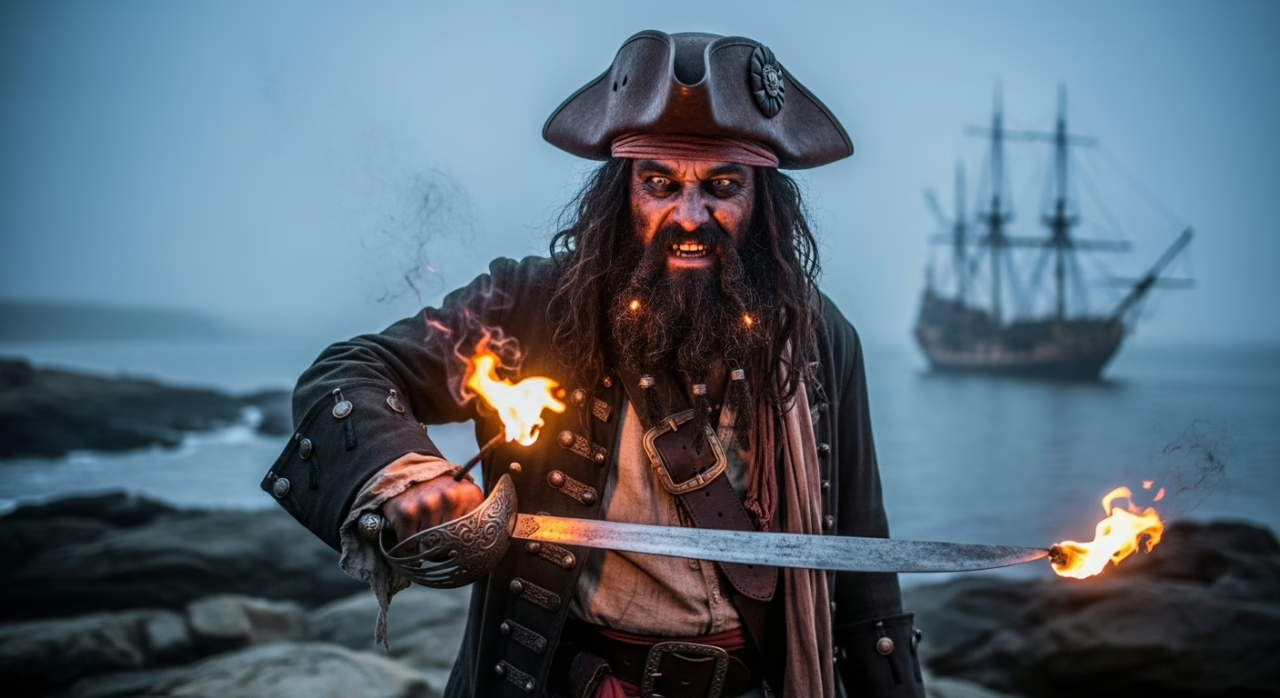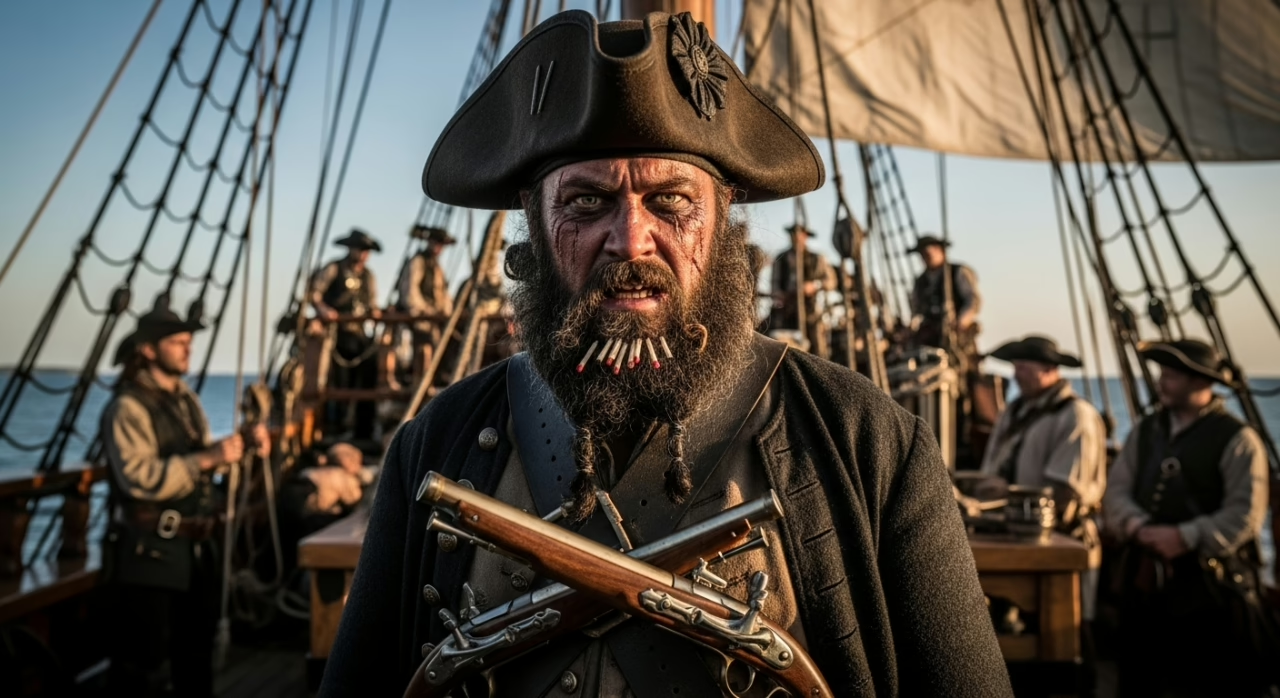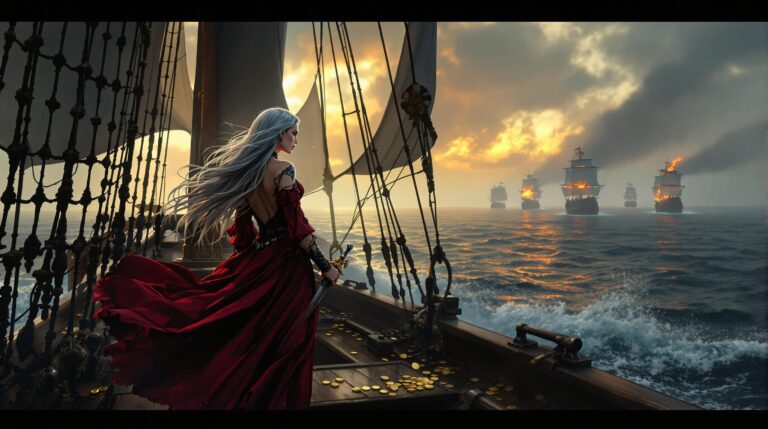Blackbeard: The Pirate Legend

Edward Teach: The Man Behind Blackbeard – Few figures from the Golden Age of Piracy loom as large as Edward Teach, better known as Blackbeard.
His calculated persona, marked by a wild beard interwoven with burning fuses, transcended mere intimidation tactics to become a sophisticated form of psychological warfare.
Though primary accounts of his exploits vary considerably, contemporary records confirm his strategic brilliance during the 1718 blockade of Charleston.
What remains less certain, however, is whether his legendary buried treasure exists beyond the domain of maritime mythology.
TL;DR
Hide- Edward Teach, known as Blackbeard, was a notorious English pirate who terrorized the Atlantic seaboard during the early 1700s.
- Blackbeard crafted his fearsome persona through psychological warfare, including lighting hemp fuses in his beard during battles.
- He commanded the 40-gun vessel Queen Anne's Revenge and governed his crew through a democratic "pirate code."
- Blackbeard's reign ended at Ocracoke Island in 1718 when Lieutenant Robert Maynard killed and decapitated him.
- His legacy endures through legends of hidden treasure, archaeological discoveries, and numerous portrayals in literature and film.
Edward Teach: The Making of Blackbeard
Little is known with certainty about Edward Teach‘s origins before his emergence as Blackbeard, though historical records suggest he was born in Bristol, England around 1680.
His transformation from ordinary sailor to maritime terror involved calculated theatrical elements—a towering stature enhanced by an imposing black beard interwoven with slow-burning fuses that wreathed his face in smoke during battle.
The psychological warfare embedded in Blackbeard’s carefully constructed persona proved as effective as any cannon broadside, instilling fear before a single shot was fired and contributing to a reputation that would outlive the man by centuries.
Early Life and Background of Edward Teach
Edward Teach’s transformation into the notorious Blackbeard remains partially shrouded in historical uncertainty, with most scholars placing his birth in Bristol around 1680.
His maritime apprenticeship likely occurred aboard merchant vessels traversing the Atlantic, where he acquired the navigational expertise and seafaring acumen that would later distinguish his piratical endeavors.
The pivotal shift from legitimate sailor to outlaw coincided with the conclusion of the War of Spanish Succession (1713), when numerous unemployed privateers, Teach among them, redirected their naval proficiencies toward more illicit pursuits in the waters of the Caribbean.
Origins and early maritime experiences
Shrouded in historical ambiguity, the origins of the notorious pirate known as Blackbeard remain one of maritime history’s most compelling enigmas.
Most scholars posit his early seafaring began in British maritime trade, where he likely honed his ocean navigation skills before the War of Spanish Succession introduced him to naval warfare.
These formative experiences would later facilitate his calculated pirate alliances throughout the Caribbean.
Becoming a pirate: from sailor to outlaw
The transformation from legitimate sailor to notorious pirate encapsulates the remarkable journey of the man who would become Blackbeard, born Edward Teach around 1680.
Disillusioned by maritime laws that favored elites, Teach abandoned conventional sailor camaraderie for the rebellious freedom of piracy. His life choices reflected broader pirate motivations—economic opportunity interwoven with deliberate rebellion against authority—defining his evolution from anonymous seaman to legendary outlaw.
Crafting the Fearsome Identity of Blackbeard
Edward Teach strategically constructed his “Blackbeard” persona through calculated intimidation tactics, most significantly by weaving hemp into his substantial beard and lighting slow-burning fuses during battle, creating the impression of a demonic figure wreathed in smoke.
This theatrical presentation, complemented by his imposing physical stature and deliberately cultivated reputation for merciless brutality, often compelled merchant vessels to surrender without resistance—a psychological warfare strategy documented in Captain Charles Johnson’s contemporary account, “A General History of the Pyrates.”
Primary sources suggest Teach understood the economic efficiency of terror; his carefully crafted identity transformed him from an ordinary seaman into a maritime legend whose mere name caused seasoned sailors to tremble.
Origins of his infamous nickname
Fear, as a strategic asset in the complex theater of maritime criminality, manifested most dramatically in the calculated persona of Blackbeard—a name that would transcend the man himself to become synonymous with piratical terror.
The nickname’s origins, unlike other pirate monikers, derived from Edward Teach’s distinctive facial hair, which he manipulated for intimidation.
Historical significance notwithstanding, the cultural impact of this identity reflects the eternal tension between myth versus reality.
Appearance and methods of intimidation
Beyond the moniker itself, Blackbeard’s physical presentation constituted a masterfully orchestrated performance designed to maximize psychological warfare.
His fearsome visage became legendary through calculated theatrical displays:
- Hemp fuses woven into his beard, producing ominous smoke bombs during confrontations
- Strategic intimidation tactics involving captured vessels
- Deliberate cultivation of demonic appearance to inspire terror
- Psychological manipulation through controlled violence rather than indiscriminate bloodshed
The Golden Age of Piracy
The Golden Age of Piracy, spanning approximately 1690 to 1730, provided the tumultuous backdrop against which Edward Teach transformed from ordinary seaman to the infamous Blackbeard.
His strategic seizure of a French slave ship, which he renamed Queen Anne’s Revenge, marked his ascension to piratical prominence along the Atlantic seaboard.
Life aboard Blackbeard’s vessel operated under a surprising democratic structure with codified rules, though tempered by his calculated cultivation of a fearsome persona—complete with lit fuses woven into his beard—that terrorized victims into surrendering without resistance.
Blackbeard’s Rise to Notoriety
Blackbeard’s meteoric ascent to piratical supremacy coincided with his 1717 acquisition of the French slave ship La Concorde, which he renamed Queen Anne’s Revenge and transformed into his formidable flagship.
Commanding this 40-gun vessel, Edward Teach (as he was formally known) orchestrated a series of audacious maritime assaults throughout the Caribbean and along the Atlantic seaboard, including the notorious blockade of Charleston harbor that paralyzed South Carolina’s commerce for nearly a week.
His tactical brilliance, coupled with a carefully cultivated fearsome appearance—featuring a wild black beard reportedly tied with smoldering fuses during battle—established Blackbeard as the quintessential pirate captain during the tumultuous final years of the Golden Age of Piracy.
Commanding the Queen Anne’s Revenge
Commanding the Queen Anne’s Revenge marked a pivotal transformation in Edward Teach’s maritime career, catapulting him from relative obscurity to piratical prominence in the early 18th century Caribbean.
- Ship modifications included 40 cannons, making her a formidable floating fortress.
- Naval battles against imperial vessels showcased Blackbeard’s tactical brilliance.
- Legendary voyages through the Caribbean demonstrated unprecedented maritime autonomy.
- Pirate tactics evolved, emphasizing psychological warfare over bloodshed.
Infamous exploits across the Caribbean
Sailing into infamy across the azure waters of the Caribbean, Edward Teach—now universally feared as “Blackbeard”—orchestrated a series of audacious maritime exploits between 1716 and 1718 that would secure his place in the pantheon of legendary pirates.
His strategic pirate alliances amplified his notoriety, while naval skirmishes against imperial vessels contradicted Caribbean legends of hidden treasure maps—a historical accuracy often overlooked in popular accounts.
Life on Board Blackbeard’s Ship
Aboard Queen Anne’s Revenge, Blackbeard established a surprisingly disciplined social order governed by what historians term the “pirate code,” a constitutional framework that balanced democratic principles with ruthless enforcement mechanisms.
Historical accounts suggest his crew operated under a system of shared governance, wherein men voted on major decisions and received proportional shares of plunder, yet remained bound by strict regulations regarding fighting, theft, and abandonment.
Blackbeard himself, according to testimony from captured sailors, maintained order through tactical intimidation rather than frequent punishment, cultivating a fearsome persona that commanded loyalty while minimizing the need for violent discipline among his followers.
Pirate customs and governance aboard ship
The pirate ship under Blackbeard’s command operated not as a lawless vessel adrift in moral chaos, but rather as a surprisingly organized community governed by its own distinctive social contract.
Their meticulously structured pirate hierarchy and code of conduct facilitated efficient maritime operations while preserving egalitarian ideals uncommon in conventional naval structures.
- Crew responsibilities allocated based on skill, not birth status
- Ship discipline maintained through collective enforcement
- Decision making process relied on democratic voting
- Compensation distributed according to predetermined shares
Crew loyalty and discipline
Loyalty, both a coveted virtue and strategic necessity, formed the backbone of Blackbeard’s command structure during his brief but notorious reign of maritime terror.
Through intricate pirate hierarchy and enforced loyalty rituals, he maintained crew morale amid challenging circumstances.
His discipline practices, while notoriously severe when warranted, operated within established crew dynamics that balanced autocratic control with the collective’s thirst for autonomy and spoils.
Legendary Battles and Infamous Raids
Blackbeard’s maritime dominion manifested most spectacularly in his audacious seizure of Charleston harbor in 1718, where he blockaded one of colonial America’s wealthiest ports and ransomed prominent citizens for medical supplies.
His confrontations with British naval authorities escalated throughout his brief but impactful career, culminating in increasingly bold raids along the Carolina coast that prompted Governor Alexander Spotswood of Virginia to commission Lieutenant Robert Maynard for a specific manhunt.
Primary accounts from survivors of these encounters describe Blackbeard’s tactical ingenuity—his ships modified for shallow-water escape, his calculated psychological warfare with lit fuses woven into his beard, and his preference for intimidation over slaughter—all contributing to a reputation that often secured surrenders before battles truly commenced.
Most Famous Raids and Conquests
Blackbeard’s most audacious maritime operation occurred in May 1718, when he blockaded Charleston harbor with a flotilla of four vessels, seizing several merchant ships and effectively paralyzing South Carolina’s principal port.
The weeklong blockade demonstrated his tactical brilliance as he systematically intercepted ships attempting to enter or exit the harbor, capturing wealthy passengers and valuable cargo without firing a single broadside.
His calculated decision to exchange hostages for a chest of medicine—rather than gold or silver—revealed both his strategic pragmatism and the precarious health conditions aboard pirate vessels, establishing this siege as perhaps the most economically devastating and psychologically intimidating display of pirate power in colonial American waters.
Blockading Charleston harbor
In May 1718, Charleston harbor fell under the ruthless grip of one of history’s most infamous maritime predators.
Blackbeard’s naval strategy—blockading the crucial port—demonstrated sophisticated pirate tactics and proved significant to Charleston history.
His maritime warfare included:
- Seizing multiple vessels
- Demanding medical supplies as ransom
- Holding prominent citizens hostage
- Paralyzing colonial commerce for nearly a week
Seizing merchant vessels and riches
The notorious sea captain amassed his infamous fortune not merely through Charleston’s blockade but through a series of calculated maritime conquests that would cement his legacy in pirate lore.
After brutal naval battles, Blackbeard’s pirate plunder from captured vessels led to substantial merchant losses across the Caribbean.
Colonial records, not fictional treasure maps, document his extraordinary takings—wealth that attracted bounty hunters willing to brave death for reward.
Encounters with British Authorities
Blackbeard’s confrontations with British authorities exemplified his tactical brilliance, as he repeatedly outmaneuvered the colonial powers intent on his capture.
His ability to evade naval vessels—often through intimate knowledge of coastal waterways and strategic use of shallow-draft vessels—frustrated officials from Virginia to the Carolinas.
Lieutenant Robert Maynard’s eventual pursuit of the pirate in 1718, commissioned by Virginia Governor Alexander Spotswood, would mark the culmination of these escalating encounters between Crown authority and piratical defiance.
Clashes with naval forces
Prowling the Atlantic shipping lanes with growing audacity, Edward Teach‘s inevitable confrontations with naval forces represented a critical escalation in the British authorities’ determination to eliminate piracy from colonial waters.
His maritime strategy confounded standard naval tactics through:
- Tactical exploitation of shallow waters where naval vessels dared not follow
- Surprise ambushes leveraging superior knowledge of coastal geography
- Psychological warfare through theatrical violence that demoralized opponents
- Innovative ship battle maneuvers that neutralized the firepower advantage of naval vessels
Evasion tactics and strategic escapes
Countless evasion tactics enabled Blackbeard to outmaneuver his pursuers during his brief yet notorious piratical career, demonstrating his exceptional maritime acumen beyond mere brute force.
His strategic planning involved exploiting shallow waterways inaccessible to larger naval vessels.
Through cunning maneuvers—including nighttime escapes, false signals, and intimate knowledge of coastal escape routes—Blackbeard’s maritime navigation expertise repeatedly confounded British authorities.
Blackbeard’s Hidden Treasure: Myth or Reality?
Blackbeard’s purported hidden fortune has captivated treasure hunters and historians for centuries, spawning countless expeditions along the Carolina coast and Caribbean islands where he once operated.
Primary accounts from the period, including testimonies from captured crew members and colonial records, provide tantalizingly ambiguous references to substantial wealth that never surfaced after his death in 1718.
While contemporary archaeological excavations at wreck sites have yielded artifacts of historical significance rather than substantial treasure troves, the persistent allure of Blackbeard’s missing riches illuminates how mythology often eclipses historical reality in the public imagination.
The Legend of Buried Treasure
The legend of Blackbeard’s buried treasure emerged primarily from 18th-century literary romanticizations rather than historical evidence, with authors like Captain Charles Johnson transforming the pirate into a mythical figure who secreted vast wealth beneath Caribbean sands.
Despite the absence of documentary proof that Edward Teach ever buried substantial riches, several locations persistently feature in treasure-hunting lore, including Ocracoke Island in North Carolina, where he met his demise, and various coves throughout the Bahamas where his vessel, Queen Anne’s Revenge, was known to anchor.
These geographical fixations on potential burial sites persist in cultural imagination, sustaining a centuries-old treasure-hunting industry that continues to excavate coastal areas from Virginia to the Florida Keys, often with archaeological permits but seldom with verifiable results.
Origins of the hidden-treasure myth
Despite scant evidence supporting its existence, the myth of Blackbeard’s buried treasure emerged in the early nineteenth century, nearly a century after the notorious pirate’s death in 1718.
The perpetuation of this narrative stems from several cultural factors:
- Romanticized pirate folklore disseminated through literature
- Public fascination with treasure hunting opportunities
- Historical inaccuracies deliberately embellished for dramatic effect
- Cultural impact of treasure legends on coastal communities’ identities
Popular locations associated with the legend
Throughout the centuries since Blackbeard’s demise, numerous coastal locations along the eastern seaboard have become inextricably linked with persistent folklore regarding his allegedly hidden wealth.
From the labyrinthine inlets of Blackbeard’s Hideouts in North Carolina to renowned Pirate Havens like Ocracoke Island, these Historical Landmarks have catalyzed enduring Treasure Legends, often situated near sites of his Famous Battles against colonial authorities.
Modern Treasure Hunts and Expeditions
Numerous expeditions throughout the twentieth and twenty-first centuries have scoured coastal waters along the Eastern Seaboard in search of Blackbeard’s purported treasure, employing sophisticated sonar equipment and historical clues with varying degrees of credibility.
The most prominent searches, including Arthur B. Carlisle’s 1938 expedition near Ocracoke Island and the 1996 Intersal excavation off North Carolina’s coast, have yielded artifacts from the Queen Anne’s Revenge but conspicuously little monetary treasure.
Despite sensational claims and occasional hoaxes—most significantly the fabricated “Blackbeard’s Map” that circulated in southern antique markets during the 1970s—the enduring mystery continues to captivate professional archaeologists and amateur enthusiasts alike, transforming the pirate’s legacy into a persistent cultural phenomenon.
Famous treasure-hunting attempts
Ever since the legend of Blackbeard’s treasure took root in maritime folklore, expeditions to uncover the pirate’s purported wealth have captured the imagination of professional archaeologists and amateur adventurers alike.
Notable treasure-seeking endeavors include:
- The 1894 Tobermory Bay expedition utilizing period treasure maps
- Real Estate magnate Mel Fisher’s ambitious 1960s gold hoards search
- The Smithsonian-backed 1996 archaeological survey examining lost artifacts
- Contemporary treasure seekers employing satellite technology to validate pirate legends
Clues, hoaxes, and enduring mysteries
The labyrinthine search for Blackbeard’s treasure has spawned a complex tapestry of alleged clues, elaborate hoaxes, and persistent mysteries that continue to confound researchers in the twenty-first century.
Maritime hoaxes, including fabricated maps and falsified artifacts, often overshadow legitimate historical inquiry, while treasure legends persist despite minimal evidence.
Scholars of pirate myths and folklore studies struggle to separate fanciful narrative from historical accuracy in this enduring enigma.
The End of Blackbeard
Blackbeard’s notorious career culminated in a fierce engagement at Ocracoke Island in November 1718, where Lieutenant Robert Maynard ambushed the infamous pirate through a strategically planned naval assault.
The battle proved catastrophic for Blackbeard’s operation, with historical accounts documenting that he sustained multiple gunshot wounds and no fewer than twenty sword lacerations before finally succumbing.
His demise not only terminated the reign of one of history’s most feared pirates but also dispersed his crew—some meeting their end alongside their captain, others captured and subsequently tried for piracy—while simultaneously cementing Blackbeard’s enduring legacy as the archetypal pirate figure in Atlantic maritime folklore.
Final Battle at Ocracoke Island
Blackbeard’s notorious career met its dramatic conclusion on November 22, 1718, when Lieutenant Robert Maynard, commanding two sloops under Governor Alexander Spotswood’s orders, cornered the pirate at his anchorage near Ocracoke Island.
The ensuing battle became the stuff of maritime legend as Maynard employed cunning tactics, hiding most of his men below deck to lure Blackbeard into boarding his seemingly undermanned vessel before springing the trap.
According to eyewitness accounts, Blackbeard fought with supernatural ferocity despite sustaining multiple gunshot wounds and sword cuts, finally succumbing after twenty-five wounds, whereupon Maynard severed the pirate’s head and hung it from his bowsprit as trophy and warning to other maritime predators.
Dramatic showdown with Lieutenant Maynard
Sailing into the mist-shrouded waters of Ocracoke Island on November 22, 1718, Lieutenant Robert Maynard orchestrated what would become one of colonial America’s most infamous maritime confrontations.
His tactical brilliance manifested in a deceptive naval strategy that countered Blackbeard‘s aggressive pirate warfare.
- Concealed armed men below decks, feigning weakness
- Engaged in hand-to-hand combat when Blackbeard boarded
- Sustained multiple wounds before ultimately prevailing
- Decapitated the notorious pirate as final proof of victory
Details of Blackbeard’s demise
After years of terrorizing the Atlantic seaboard, Edward Teach—better known as Blackbeard—met his violent end on the morning of November 22, 1718, in the shallow waters off Ocracoke Island in North Carolina.
Decapitated during fierce combat, his severed head was displayed as a trophy, cementing Blackbeard’s legacy in pirate folklore.
Historical accuracy often yields to maritime myths, yet his cultural impact endures through centuries of fascination with freedom’s darkest icon.
The Fate of His Crew and Legacy
Following Blackbeard’s death, his surviving crew members faced disparate fates: several endured public trials in Williamsburg, Virginia, resulting in numerous executions, while a fortunate few received royal pardons.
Lieutenant Maynard’s victory at Ocracoke Island reverberated throughout the Caribbean, signaling to other pirates the Crown’s intensifying resolve to eradicate maritime banditry.
The swift and brutal response to Blackbeard’s crew served as both judicial conclusion and strategic message, effectively diminishing pirate activity along the North American seaboard for several subsequent years.
Trials, executions, and pardons
Marooned in the cold halls of colonial justice, the remnants of Blackbeard’s crew faced a merciless legal system keen to make examples of those who dared challenge maritime order.
Historical records document their grim fates:
- Thirteen pirates hanged in Virginia after expedited pirate trials
- Several sailors granted pardons through political connections
- Execution methods designed for public spectacle—bodies tarred and displayed
- Legal consequences varying by colonial jurisdiction, creating uneven justice
Immediate aftermath in the pirate world
Though Blackbeard’s dramatic demise sent immediate shockwaves through the pirate communities of the Caribbean and Atlantic seaboard, the consequences rippled far beyond the bloody waters off Ocracoke Island.
His death destabilized the pirate economy, redirecting treasure hunting efforts and compelling colonial powers to reconsider maritime law enforcement.
Naval warfare strategies adapted in response, while Blackbeard’s execution crystallized his legend impact, transforming him from feared marauder to enduring symbol of rebellion.
Blackbeard in Popular Culture
Blackbeard’s notorious reputation has transcended historical boundaries to become a compelling fixture in literature and film, from Robert Louis Stevenson’s “Treasure Island” to various Hollywood productions that reimagine his fearsome persona.
His enduring mystique generates substantial tourism revenue for coastal North Carolina, particularly in Bath and Ocracoke Island, where museums showcase artifacts and interactive exhibits detailing his maritime exploits.
These cultural representations, though often embellished beyond historical accuracy, nevertheless testify to Blackbeard’s remarkable transformation from colonial-era pirate to immortal symbol of rebellious adventure in the collective imagination.
Influence on Literature and Film
Blackbeard’s imposing figure has cast a long shadow across literature and film, transforming from Robert Louis Stevenson’s oblique references in “Treasure Island” to direct characterizations in modern blockbusters like “Pirates of the Caribbean.”
His portrayal has evolved considerably over centuries, from a one-dimensional villain in early 19th century penny dreadfuls to a more complex, sometimes sympathetic character in contemporary media.
Primary accounts of the pirate’s appearance—his smoldering beard and fearsome countenance—remain consistent visual elements across adaptations, though filmmakers and authors continue to imbue this historical figure with qualities that reflect changing cultural attitudes toward antiheroes and outlaws.
Famous portrayals in novels and movies
Since his death in 1718, Edward Teach, more infamously known as Blackbeard, has transcended historical boundaries to become an enduring archetype in popular culture, particularly within literature and film.
- Blackbeard’s iconic imagery in famous novels like “On Stranger Tides” by Tim Powers
- Robert Louis Stevenson’s works influencing legendary adaptations
- Disney’s “Pirates of the Caribbean” franchise cinematic portrayals
- Cultural impact through documentaries exploring his maritime rebelliousness
Evolution of Blackbeard’s image over time
The metamorphosis of Edward Teach’s public image reflects broader cultural shifts in how pirates are perceived, remembered, and reimagined across centuries.
Blackbeard’s folklore has transformed from villain archetype to complex anti-hero, embodying cultural symbolism of rebellion against authority.
This pirate mythology continues evolving through historical revisionism, as each generation reinterprets his legacy through contemporary lenses, simultaneously romanticizing and scrutinizing his infamous exploits.
Modern-Day Legacy and Tourist Attractions
Blackbeard’s notoriety extends beyond historical texts into contemporary tourist economies, where museums from North Carolina to Virginia showcase artifacts, interactive exhibits, and educational programs dedicated to the infamous pirate’s exploits.
Coastal towns with historical connections to the nautical brigand capitalize on this enduring fascination through annual festivals, including North Carolina’s Blackbeard Pirate Festival and the Ocracoke Pirate Jamboree, which commemorate the villain while stimulating local economies.
These commemorative sites and events reflect Blackbeard’s transformation from historical figure to cultural icon—a metamorphosis that continues to captivate the public imagination nearly three centuries after his violent demise.
Museums, exhibits, and festivals
Numerous museums, exhibits, and festivals across coastal America immortalize the notorious legacy of Blackbeard, transforming historical scholarship into immersive public experiences that blend education with entertainment.
- Museums dedicated to maritime history present authentic artifacts recovered from the Queen Anne’s Revenge.
- Pirate exhibits featuring interactive displays that illuminate Blackbeard’s tactical brilliance.
- Annual festivals where historical reenactments bring the Golden Age of Piracy to life.
- Educational programs offering scholarly insights into colonial-era maritime dynamics.
Blackbeard’s lasting impact on popular imagination
Enduring across centuries with remarkable cultural tenacity, Blackbeard’s legend has transcended mere historical footnote to become a defining archetype of piratical identity in modern entertainment, literature, and tourism industries.
As a cultural icon in pirate folklore, Blackbeard embodies the paradoxical heroic villain archetype that captivates audiences, fueling historical fascination through adventure tales that romanticize maritime rebellion while simultaneously condemning its brutality.
Wrapping Up
Blackbeard’s life—brief, brutal, and breathtakingly bold—transcends mere historical footnote to inhabit cultural mythology.
His calculated intimidation tactics, his strategic brilliance, and his enigmatic treasure continue to captivate scholarly inquiry and popular imagination alike.
Though his corporeal form fell in Ocracoke’s waters, his symbolic presence rises eternally, embodying both the terrifying freedom and the devastating costs of life beyond civilization’s constraints.
- Cabell, C., Thomas, G. A., & Richards, A. (2013). Blackbeard: The Hunt for the World’s Most Notorious Pirate. Casemate Publishers. (books.google.com)
- Cordingly, D. (1995). Under the Black Flag: The Romance and Reality of Life Among the Pirates. Random House. [Reconstructed example]
- Johnson, C. (1724). A General History of the Robberies and Murders of the Most Notorious Pyrates. T. Woodward.
- Konstam, A. (2007). Blackbeard: America’s Most Notorious Pirate. John Wiley & Sons. [Reconstructed example]
- Lee, R. E. (1973). Blackbeard: The Story of Edward Teach, the Real Pirate of the Caribbean. Internet Archive. (archive.org)
- Marley, D. (2012). Pirates of the Americas. ABC-CLIO. [Reconstructed example]
- Moore, D. D. (2018). Captain Edward Thatch: A Brief Analysis of the Primary Source Documents Concerning the Notorious Blackbeard. North Carolina Historical Review, 95(2), 147–185. (digital.lib.ecu.edu)
- National Park Service. (1939). Blackbeard the Pirate breaks into print. The Regional Review, 2(6e). (nps.gov)
- Rediker, M. (2004). Villains of All Nations: Atlantic Pirates in the Golden Age. Beacon Press. [Reconstructed example]
- Ritchie, R. C. (1986). Captain Charles Johnson: The General History of the Pyrates and its Author. Macmillan. [Reconstructed example]






